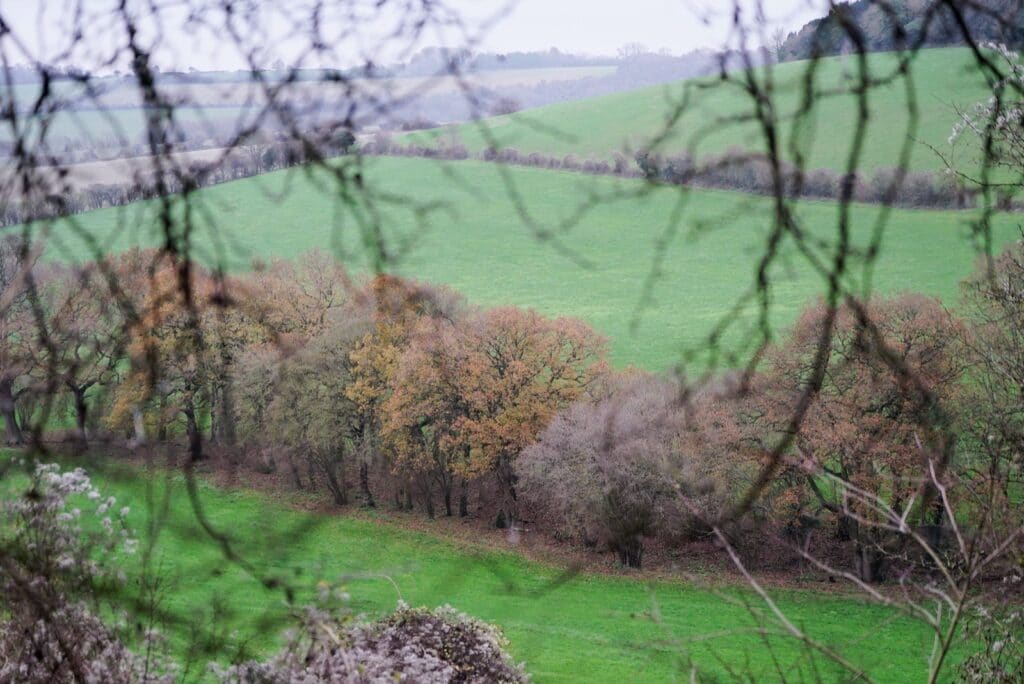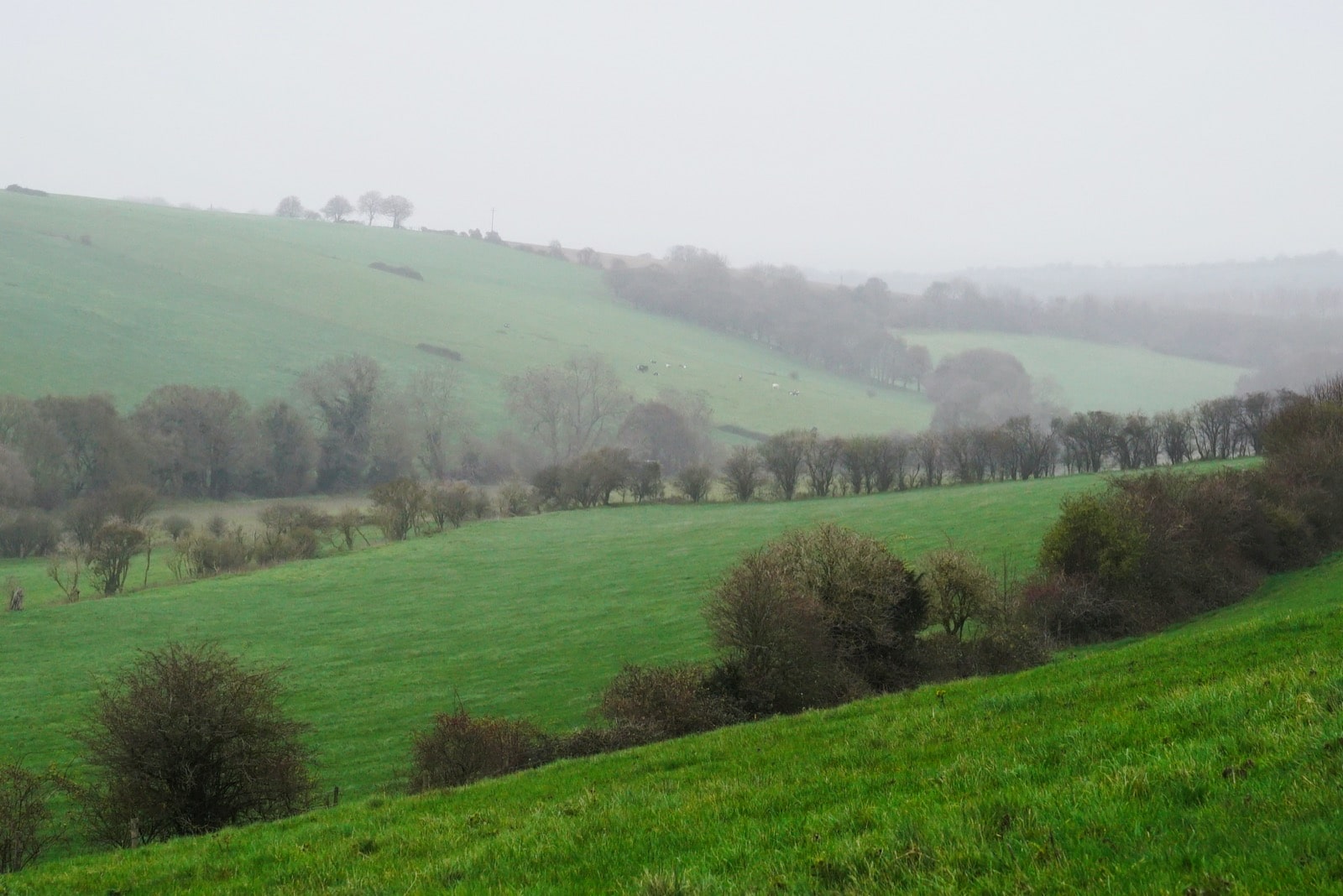[Here’s a link to other forays around my map.]
I was looking forward to today’s grid square. With practice a map becomes as clear as a book, and as full of imagined detail. This square looked as hilly and natural as almost any on my map: a rare treat in this flat, urbanised area. A lone farm at the top-left corner was the only building, and just one small road shaved the left-hand side of the square. The rest of the kilometre square seemed to be empty.
From a thin strip wood on the western side, the land dropped steeply down for about 50 metres; the most notable hill I have encountered so far. Along the southern edge of the square the land climbed just as steeply up into a wood, fell away again, then climbed all the way up once more. In cross-section it would resemble a ‘W’. The hilltop ran roughly along the eastern edge of the square, including 600 metres of bridleway – the only permitted access on all this empty land. Finally, the northern boundary of the square was a single valley, a large ‘U-shape’ in cross-section. I love land with contour lines! It feels filled with possibility and variety.


Even so, I found it hard to escape the tyranny of my mobile phone as I began walking. I had to force myself to put it away, reminding myself that I was here to pay attention. First up, of course, was a heap of fly-tipping and the latest edition to my full-McDonalds-Menu-of-Litter: a plastic McCafe Iced coffee cup. Equally predictable: a Coca Cola bottle (Coca-Cola has once again been named the world’s biggest plastic polluter).
At each small passing place (the road was narrow) was evidence of someone winding down their car window and lobbing out their day’s rubbish. I can’t imagine ever doing this! The National Federation of Women’s Institutes began a campaign in 1954 to “Keep Britain Tidy”. The familiar logo (named Tidyman) started appearing on bins and packaging in 1969. From the 1970s national campaigns, featuring the celebs of the day, were everywhere. The Dangerous Litter Act increased maximum littering fines from £10 to £100 and 1990 was named Tidy Britain Year. In 2017 the government published its Litter Strategy for England, and in 2019 over 560,000 volunteer #LitterHeroes took part in a Great British Spring Clean – making it the country’s biggest ever mass-action environmental campaign. And after all that we still drop 30 million tonnes of litter every year!
In America, the phrase “Don’t Mess with Texas” is prominently shown on road signs on major highways, television, radio and in print advertisements across Texas. The campaign is credited with reducing litter on Texas highways roughly 72% between 1987 and 1990. The campaign’s target market was 18- to 35-year-old males, which was statistically shown to be the most likely to litter.
Yet some caution that a narrow focus on litter is seen as an attempt to divert responsibility from industries that manufacture and sell disposable products to the consumer that improperly disposes of the related non-returnable wrappers, filters, and beverage containers.
After World War II, the story goes, American manufacturers were running at full blast, and needed American consumers to keep buying more and more junk if they wanted to maintain their profit margins. And since there’s an upper limit to how much junk a given family genuinely needs to own, manufacturers had to figure out how to convince consumers to keep throwing their existing stuff out, so that they would buy new stuff.
In part, that meant companies had to ensure that in a few short years consumer goods would become either unfashionable (advertising can do that), or obsolete (simply stop offering customer support for anything a few years old), or broken (like the non-replaceable batteries in iPhones that wear out after two years). And so our pandemic of littering and plastic began.
I noticed that someone had tossed away a banana peel. Far less of a problem than plastic, certainly (consider, after all, that every toothbrush you have ever used still exists), but fruit takes longer to decompose than people imagine. It has even been causing a problem on Britain’s most popular mountains. Heaps of discarded banana skins are being found littered across Ben Nevis. The peelings, left by some of the 160,000 visitors to Britain’s highest mountain, can take as long as two years to degrade. The John Muir Trust, which manages visitor impact on Ben Nevis, removed 1,000 banana skins from the summit during a clean-up of litter.


December is such a quiet month in England. In fact the only sound I could hear were distant cars. When did that become normal? Everything felt flat and drab. But I was glad to be beginning this project at the tail end of the year so that I can experience everything perking up with longer days. Hopefully I will be far more aware of those changes than usual.
Just then a few crows flew across my eyeline. Although it’s not a ‘few’ crows, of course, for we have the weird world of animal collective nouns which deems this to be a ‘murder’ of crows. Most of the collective nouns we use date back to the mid 15th century, including a wake of buzzards, a commotion of coots, an asylum of cuckoos, a curfew of curlews, a crown of kingfishers, and a conspiracy of ravens.
But how was I to know I was watching a murder rather than a conspiracy? How do you tell the difference between all the dark corvids? Remember the old saying, “a crow in a crowd is a rook and a rook on its own is a crow”. This holds true for the most part. The lonely ‘caw’ of a crow is often the only birdsong on autumn and winter lowlands. Rooks are highly sociable throughout the year, nesting in colonies, feeding in groups and, in winter, flocking together in groups of hundreds, sometimes thousands of birds. Rook pie – made from the fledgling youngsters – was once a rural staple across Britain.
A farmhand flailing a hedge with his tractor didn’t notice me pass. He was the only person I saw all afternoon. I pushed through the thin strip of woodland and stood on the valley’s edge, with what felt like a huge expanse of open space before me. This was the closest I have come to ‘proper’ countryside and hills in many a month and I felt a happiness and a peace welling up inside me. I have a yearning for space and solitude that I tend to underestimate until a moment like this reminds me what I have been missing. It was a plain winter’s day: grey, damp and two-dimensional. But from this viewpoint the foggy haze appeared cozy and private.


Although I had never been here before, the landscape felt familiar and welcoming to me. Rolling green fields are a classic British pastoral snapshot. I grew up amongst hills and fields such as these and am very fond of them. But it is only in recent times that I have noticed how uniform the lush, nitrogen green fields are. Many are planted with Grass Seeds Mixtures designed specifically for UK dairy farms to maximise nutrition, reduce feed cost and improve the profitability of UK dairy farming. In terms of wildlife and biodiversity, this results in a green desert.
Although this was grazing pasture I could not see a single cow. They had been packed into winter sheds to be fed a high-protein diet that boosts milk production. When I walked past the farm later I had to wade through ankle deep slurry that oozed under the vast cowshed doors. The skewed world of industrial farming: empty fields and animals crammed into polluting indoor sheds.
I eventually did see a cow in the final field of my walk. About 20 of them suddenly ran in my direction to say hello. I’m fond of cows but I erred towards caution as they galloped my way! I hurdled quickly over a fence with a yellow sign ‘Warning Bull in Field’ and said hello to the cows from the other side of the fence.


But I’m getting ahead of myself. For I still had to walk down the hill, up the other side, down again, and then back up: such exertion is rare in the liminal suburban lands around London! I delighted in it, my quads warming with the effort, my eyes greedily taking in the ever-changing views and, best of all, my fingers no longer twitching to take out my phone and ‘just quickly check…’. At the highest point I stopped for lunch, sitting under a scrubby hawthorn tree to keep off some of the drizzle.
I took a thermos flask from my rucksack and poured a mug of steaming, bright red beetroot soup. Hot and colourful and the perfect antidote to the day’s weather. I have become a soup-making fiend, revelling in its ease and affordability. Here is my infallible recipe:
- Find the section of your supermarket with the discounted products destined to be thrown away that evening. Buy a random assortment of vegetables, plus a dented tin or two of beans, lentils, or chickpeas.
- Next time you use your oven, roast the vegetables (plus an onion and loads of garlic).
- Blend together with stock, seasoning, and any spices you like.
- Add the beans or lentils.
- Enjoy.
Cooking becomes far easier and less-constricting when you learn a few principles and can treat recipes as ideas rather than formulae. (The book Salt, Fat, Acid, Heat brilliantly outlines some of the elements of good cooking.)
Evidence of the existence of soup can be found as far back as about 20,000 BC. Boiling was not a common cooking technique until the invention of waterproof containers (which probably came in the form of clay vessels). Animal hides and watertight baskets of bark or reeds were used before this. To boil the water hot rocks were used. This method was also used to cook acorns and other plants.
The word soup comes from French soupe (“soup”, “broth”), which comes through Vulgar Latin suppa (“bread soaked in broth”) from a Germanic source, from which also comes the word “sop”, a piece of bread used to soak up soup or a thick stew.
The word restaurant (meaning “[something] restoring”) was first used in France in the 16th century, to refer to a highly concentrated, inexpensive soup, sold by street vendors, that was advertised as an antidote to physical exhaustion. In 1765, a Parisian entrepreneur opened a shop specializing in such soups. This prompted the use of the modern word restaurant for the eating establishments. Today, Campbell’s ‘Tomato’ (introduced in 1897), ‘Cream of Mushroom’, and ‘Chicken Noodle’ (introduced in 1934) are three of the most popular soups in America. Americans consume approximately 2.5 billion bowls of these three soups alone each year.
In the region where I live 440 people are squashed into every square kilometre. And here was I with almost a whole grid square to myself, slurping soup. I felt very lucky. What more can I say?






Another good report & Selfy!
Have you seen the Primus 0.5 litre flask. You can get a couple of medium sized dumplings in with you soup.
Subject to weather my next square is a Roman fort. The last one, a ford, was superb but would have been better on my off road bike!
Another great grid square exploration. Love the variety of things you find and write about during these sessions. Thanks for sharing.
Thank you! I’m relieved it’s not just my mind that’s intrigued by everything.
Brilliant idea, will enjoy reading these, and will try and do the same here in Montana! Thanks as always for inspiring and reminding that joy is a choice.